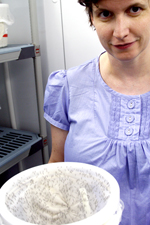Mosquitoes on demand
New Burt Hall insectary can produce 5,000-10,000 skeeters a week
After nearly half a million dollars in renovations, a new insectary in Burt Hall is up and running.
 Kristin Michel and Rollie Clem, researchers with the Division of Biology, led the project. Michel said it enables them to breed the exact mosquitoes they need for their research on malaria and mosquito-borne viral diseases. It also acts as a resource to other researchers on campus.
Kristin Michel and Rollie Clem, researchers with the Division of Biology, led the project. Michel said it enables them to breed the exact mosquitoes they need for their research on malaria and mosquito-borne viral diseases. It also acts as a resource to other researchers on campus.
The insectary consists of six dedicated rooms, two of which are used to rear mosquitoes. Currently Anopheles gambiae, the variety connected to the spread of human malaria, and Aedes aegypti, the main vector of dengue and yellow fevers, are being bred.
Each rearing room has two incubators. Since female mosquitoes need to feed on blood to produce eggs, an artificial feeding system has been set up so that live animals -- like mice -- don’t have to be used, Michel said.
The adult mosquitoes are kept in 1.5-gallon containers covered in mesh, where they lay their eggs onto wet filter paper. The eggs are transferred into pans filled with deionized water. The larvae hatch one to two days later and progress through four larval stages. The larvae then turn into pupae, which are placed back into the plastic containers. The full-grown mosquitoes emerge two to four days later, and are ready to feed within another two to three days. Throughout this process, the larvae are fed yeast and ground fish food. The temperature inside the incubators is kept at a balmy 80.6 degrees and 80 percent humidity. Once they hatch, the mosquitoes are ready for research and can be moved to another of the insectary’s rooms for manipulating the insects.
“This allows us to produce the kinds of mosquitoes in the quantities we and other researchers need,” Michel said. She estimates that they breed 5,000 to 10,000 mosquitoes a week.
The insectary also has a biosafety level-2 room equipped with an autoclave and added levels of containment so that researchers can perform infections that can’t be done elsewhere on campus. The sixth room is for storage. Every room in the insectary is equipped with an anteroom and two layers of mosquito netting through which any researcher must step to gain access.
The insectary was built using about $420,000 from combined sources, including the Division of Biology, the College of Arts and Sciences, the office of sponsored programs and additional grant monies.
Photo: Kristin Michel and Rollie Clem head the insectary, which breeds the species they need for research on malaria and other mosquito-borne diseases.